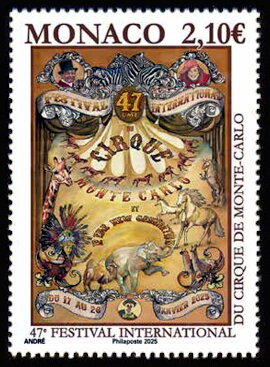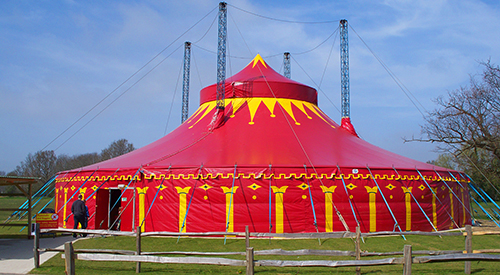Stamp: 47th International Circus Festival, Monaco (Monaco 2025)
47th International Circus Festival, Monaco (Monaco 2025)
06 January (Monaco ) within release 47th International Circus Festival, Monaco goes into circulation Stamp 47th International Circus Festival, Monaco face value 2.10 Euro
| Stamp 47th International Circus Festival, Monaco in catalogues | |
|---|---|
| Colnect codes: | Col: MC 2025.01.06-02 |
Stamp is vertical format.
Also in the issue 47th International Circus Festival, Monaco:
- Stamp - 47th International Circus Festival, Monaco face value 2.10;
- Full Pane - 47th International Circus Festival, Monaco face value 10*2.10;
Stamp 47th International Circus Festival, Monaco it reflects the thematic directions:
A circus is a company of performers who put on diverse entertainment shows that may include clowns, acrobats, trained animals, trapeze acts, musicians, dancers, hoopers, tightrope walkers, jugglers, magicians, ventriloquists, and unicyclists as well as other object manipulation and stunt-oriented artists. The term circus also describes the field of performance, training and community which has followed various formats through its 250-year modern history. Although not the inventor of the medium, Newcastle-under-Lyme born Philip Astley is credited as the father of the modern circus.
Elephants are the largest living land animals. Three living species are currently recognised: the African bush elephant (Loxodonta africana), the African forest elephant (L. cyclotis), and the Asian elephant (Elephas maximus). They are the only surviving members of the family Elephantidae and the order Proboscidea; extinct relatives include mammoths and mastodons.
The horse (Equus ferus caballus) is one of two extant subspecies of Equus ferus. It is an odd-toed ungulate mammal belonging to the taxonomic family Equidae. The horse has evolved over the past 45 to 55 million years from a small multi-toed creature, Eohippus, into the large, single-toed animal of today. Humans began to domesticate horses around 4000 BC, and their domestication is believed to have been widespread by 3000 BC. Horses in the subspecies caballus are domesticated, although some domesticated populations live in the wild as feral horses. These feral populations are not true wild horses, as this term is used to describe horses that have never been domesticated, such as the endangered Przewalski's horse, a separate subspecies, and the only remaining true wild horse. There is an extensive, specialized vocabulary used to describe equine-related concepts, covering everything from anatomy to life stages, size, colors, markings, breeds, locomotion, and behavior.



